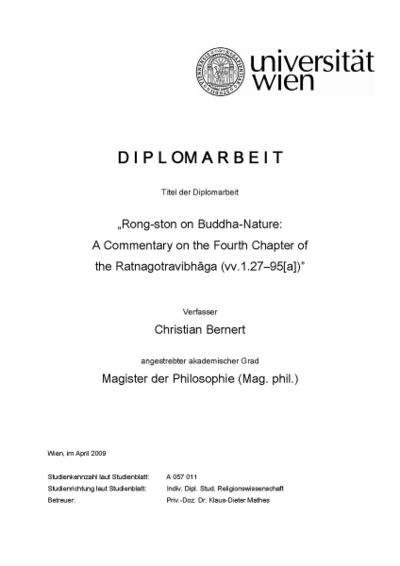- Foreword and acknowledgements 3
- Introduction 5
- 1. The doctrine of buddha-nature7
- 1.1. Overview7
- 1.2. Sources8
- 1.2.1. The sūtras8
- 1.2.2. The śāstras11
- 2. The Ratnagotravibhāga14
- 2.1. The text of the Ratnagotravibhāga14
- 2.2. The question of the authorship of the Ratnagotravibhāga15
- 2.3. The Ratnagotravibhāga in India16
- 2.4. The Ratnagotravibhāga in Tibet17
- 2.4.1. The analytical school of Blo-ldan shes-rab18
- 2.4.2. The meditative school of Btsan Kha-bo-che21
- 2.5. Previous studies and the aim of the present work22
- 3. Rong-ston and his presentation of buddha-nature25
- 3.1. A short glimpse at the life of Rong-ston Shes-bya kun-rig25
- 3.2. Rong-ston’s presentation of buddha-nature31
- 3.2.1. Introduction31
- 3.2.2. The buddha excellences and the dharmakāya33
- 3.2.3. The dhātu as a cause36
- 3.2.4. The gotra and the luminous nature of the mind37
- 3.2.5. Rong-ston and the Ratnagotravibhāgavyākhyā40
- 3.2.6. Summary41
- 4. Translation of Rong-ston’s commentary on RGV I.27–95[a]43
- 4.1. Notes on the translation43
- 4.2. The translation45
- Bibilography109
- Appendices119
- Appendix I: Outline of the translation (sab cad)119
- Appendix II: Zusammenfassung und Lebenslauf (German)123, 125
- Appendix III: Tibetan text129
Rong-ston on Buddha-Nature: A Commentary on the Fourth Chapter of the Ratnagotravibhāga
Set within the broader framework of Buddhist world view, the fundamental concern of the Tathāgatagarbha literature is to show that all sentient beings, without exception, can attain freedom from every kind of suffering and unease, and, ultimately, actualise the state of a fully awakened buddha. According to these scriptures, all sentient beings are by their very nature either empowered to attain buddhahood, or essentially already buddhas (depending on the interpretation). This innate quality of all sentient beings is given the name “buddha-nature” (Skt. tathāgatagarbha; Tib. de bzhin gshegs pa’i snying po).
This doctrine has played an important role in the history of Buddhism. Although rudimentary elements of this doctrine can be identified already within the Pāli canon,[1] those passages relating to the natural luminosity of the mind, which is said to be temporarily stained by adventitious mental afflictions, required the emergence of the Mahāyāna movement before developing into a fully fledged doctrine in its own right. Since it is supported by a number of sūtras[2] and śāstras (i.e. the Buddhist canon composed of the Buddha’s sermons and the Indian commentarial literature), it can be regarded as a third school of Indian Mahāyāna Buddhist thought, the other two being Madhyamaka and Yogācāra. However, the concept of buddha-nature reached its apogee not in India but in East Asia and Tibet where it became a cornerstone for Buddhist philosophy and religious practice. In Tibet, in particular, this concept was treated diversely by many scholars, all of whom were ambitious to fit it into the philosophical framework of their own respective schools. Rong-ston Shes-bya kun-rig (1367–1449) of the Sa-skya tradition of Tibetan Buddhism figures among the most influential of these scholars. In general, his commentary on the Ratnagotravibhāga, the main Indian śāstra on buddha-nature, and in particular, a translation of his exposition of the subject by means of ten categories, will be the focus of this work.
In the first chapter I will introduce the doctrine of buddha-nature, giving a brief account of its sources and formation. The second chapter will deal with the main treatise on buddha-nature, the Ratnagotravibhāga. Here, I will present the text itself, discuss the question of its authorship, as well as its transmission in India and early reception in Tibet. This chapter will also include a brief overview of previous studies on the Ratnagotravibhāga and the doctrine of buddha-nature. The third chapter will be devoted to the author of our treatise and his presentation of the subject. The final and main part of the work will consist of an annotated translation of a selected passage of his abovementioned commentary.
Throughout this work I have used the transliteration system of Turrell Wylie for the Tibetan. (Bernert, introduction, 5–6 )
Notes
- For example in AN I.v, 9: “This mind, O monks, is luminous! But it is defiled by adventitious defilements.” (After Mathes 2008: ix.) See also Takasaki 1966: 34–35.
- A prevalent doxographical classification of Buddhist sūtras distinguishes between the so called “three turnings of the Dharma-wheel” (a concept introduced in the Sandhinirmocanasūtra). Scriptures of the first turning fundamentally discuss the four noble truths as expounded in Nikāya Buddhism which represents the common ground for all traditions and the basic framework for all Buddhist teachings. Sūtras from second turning emphasise the doctrine of emptiness (śūnyatā) as expounded in the Prajñāpāramitā sūtras, and those of the third teach the about the three natures (trisvabhāva), the latter two being classified as belonging to the Mahāyāna corpus. The sūtras on buddha-nature are generally regarded as belonging to the third turning.
- As Seyfort Ruegg (1969: 2) remarks, the language used in the tathāgatagarbha treatises differs noticeably from that of the other two schools, and even comes suspiciously close to that of the Vedānta. Indeed, a number of modern scholars have accused this doctrine to be alien to Buddhist thought, an accusion refuted by others. For a collection of articles on this topic see Hubbard and Swanson 1997.
- Cf. Wylie 1959.
| Citation | Bernert, Christian. "Rong-ston on Buddha-Nature: A Commentary on the Fourth Chapter of the Ratnagotravibhāga". MA thesis, University of Vienna, 2009. |
|---|---|

